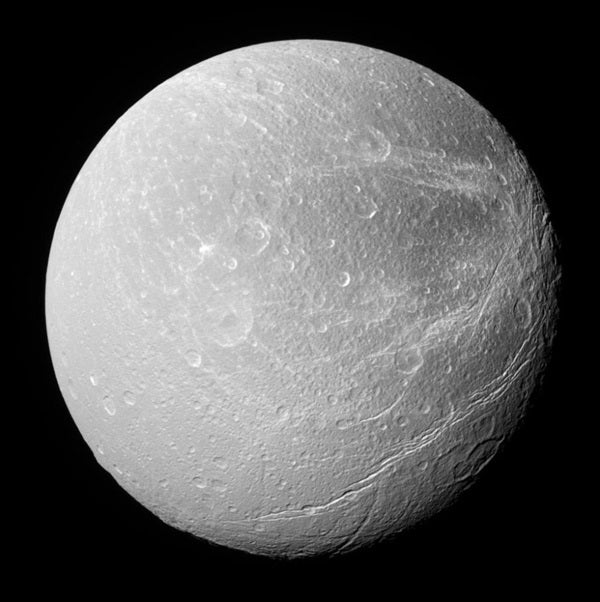The international mission made the discovery using combined data from the Cassini Plasma Spectrometer (CAPS), which includes a sensor designed and built at the University College London’s (UCL) Mullard Space Science Laboratory.
Dione joins Rhea and the main rings in Saturn’s system in having an oxygen-rich exosphere, as well as Jupiter’s moons Ganymede, Europa, and Callisto — the target for the European Space Agency’s (ESA) proposed JUpiter ICy moons Explorer (JUICE) mission for launch in 2022.
“It now looks like oxygen production is a universal process wherever an icy moon is bathed in a strong trapped-radiation and plasma environment,” said Andrew Coates from UCL. “Energetic particles hit the icy surface, the hydrogen is lost, and molecular oxygen remains as an exosphere. We now know that this happens at Saturn’s moons as well as Jupiter’s, and it may well occur in extrasolar planetary systems, too.”
Cassini flew by Dione on April 7, 2010. During that flyby, CAPS detected molecular oxygen ions near the moon’s icy surface, due to bombardment by particles trapped in Saturn’s strong magnetic field.
A team of scientists, led by Robert Tokar from the Los Alamos National Laboratory, New Mexico, used the measurements to estimate the density of the molecular oxygen ions to be in the range of 0.01 to 0.09 ions per cubic centimeter. These molecular oxygen ions are produced when neutral molecules are ionized; the measurements confirm that a neutral exosphere surrounds Dione.
Electron measurements from UCL’s electron spectrometer (ELS), part of CAPS, played a key role in reaching the conclusion of an exosphere. Data from ELS showed the plasma wake due to Dione and characterized the changes in Saturn’s magnetosphere during the flyby.
“Dione’s exosphere is very thin — compared to Earth’s atmosphere, the density is about a million billionth,” said Geraint Jones from UCL. “The exciting thing is that there is oxygen, and the oxygen may be being recycled via the surface.”










